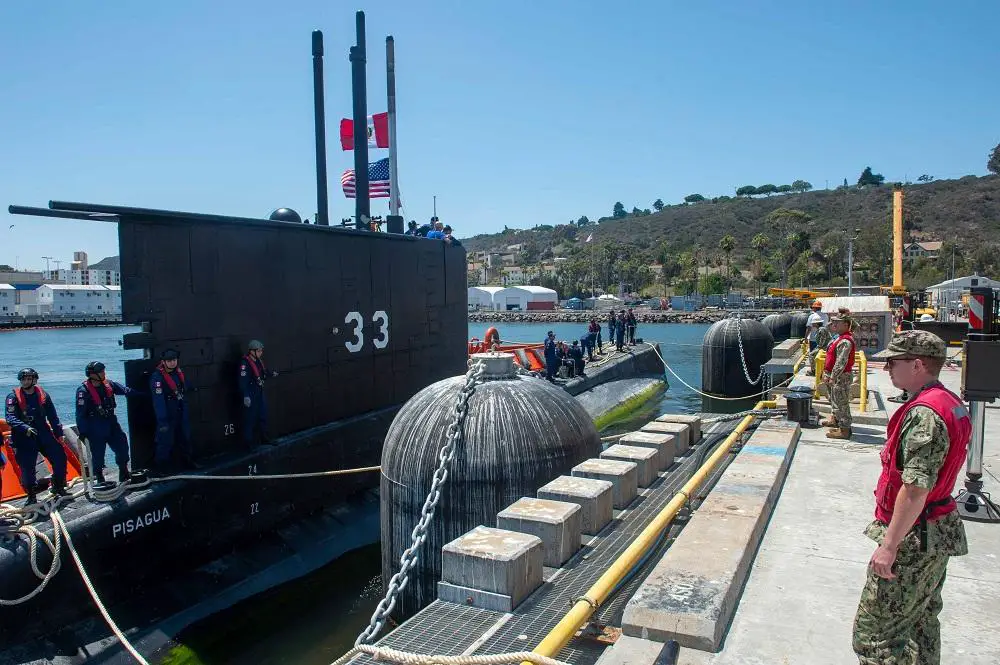Commander, Submarine Squadron 11 (CSS-11) and the Peruvian Submarine BAP Pisagua (SS-33), a German-built Type 209 submarine (SSK), partnered up to enhance and conduct training at Naval Base Point Loma (NBPL) as part of the Diesel-Electric Submarine Initiative (DESI) program, on Aug. 19, coinciding with their submarine force’s 111th birthday. The staff of CSS-11 welcomed their South American partners on the pier followed by lunch, kicking off what both expect to be the beginning of a successful partnership. DESI, established in 2001 by U.S. Fleet Forces Command, is an international program led by Commander, Submarine Force Atlantic, which works to enhance the Navy’s capability to operate with diesel-electric submarines by collaborating with South American navies. During the two-month bi-lateral training, Pisagua will participate in a multitude of different exercises, to include surface, air, and sub-surface anti-submarine warfare (ASW) exercises, a carrier strike group composite unit training exercise and a maritime patrol reconnaissance aircraft exercise.
“Anytime you are afforded the opportunity to sharpen your warfighting skills with a close ally, you can’t help but be excited. Our hope is that they learn as much from us, as we will learn from them. We are very confident that we will leave this exercise better equipped to accomplish our mission, because of the skills and tools we will have acquired from the experience. I believe we both share the common goal of wanting to be the best, and to be the best, you have to train like you fight,” said Lt. Cecilia Cajandig, the CSS-11 liaison officer for Pisagua.
“Each year, Submarine Squadron 11 looks forward to DESI and we are excited this year to be working with our Peruvian counterparts. The United States’ alliances and partnerships are an enduring strength, and training with high-end diesel submarines, like Pisagua, gives us the opportunity to maintain our competitive edge necessary in the undersea domain. These engagements help strengthen the bonds between our nations,” said Capt. Ken Douglas, commodore, CSS-11.

Sailors aboard Pisagua will also engage in training ashore at Naval Base Point Loma. The Submarine Training Facility San Diego will host the Peruvian Sailors for classroom and practical training. This includes fighting simulated fires at the firefighting trainer and learning skills to combat flooding in the damage control team trainer. Peru continues to provide invaluable support to this premier foreign submarine exercise program. During the past 19 years, Peruvian submarines have participated in a number of fleet exercises and tactical development events with the U.S. Atlantic and Pacific Fleets. The Peruvian Navy operates a total fleet of six SSKs. Notably, Peru is the largest submarine force in South America and is the second oldest in the Western Hemisphere. CSS-11 is based at Naval Base Point Loma and consists of four Los Angeles-class fast-attack submarines, the floating dry dock ARCO (ARDM 5) and Undersea Rescue Command (URC). The squadron staff is responsible for providing training, material and personnel readiness support for each of these units.
BAP Pisagua (SS-33) is one of two Type 209/1200 submarines ordered by the Peruvian Navy on 21 March 1977. It was built by the German shipbuilder Howaldtswerke Deutsche Werft AG at its shipyard in Kiel. It is named after the battle of Pisagua which took place between Chilean warships and Peruvian coastal artillery on 2 November 1879. While undergoing sea trials in the North Sea, it collided with a Soviet ship on 8 April 1982 and suffered damage which delayed its commissioning. It eventually arrived to its homeport of Callao in 1983. The Type 209 is a class of diesel-electric attack submarine developed exclusively for export by Howaldtswerke-Deutsche Werft of Germany. The original variant (Type 209/1100) was designed in the late 1960s. The class is exclusively designed for export market. Despite not being operated by the German Navy, five variants of the class (209/1100, 209/1200, 209/1300, 209/1400 and 209/1500) have been successfully exported to 13 countries, with 61 submarines being built and commissioned between 1971 and 2008.
















